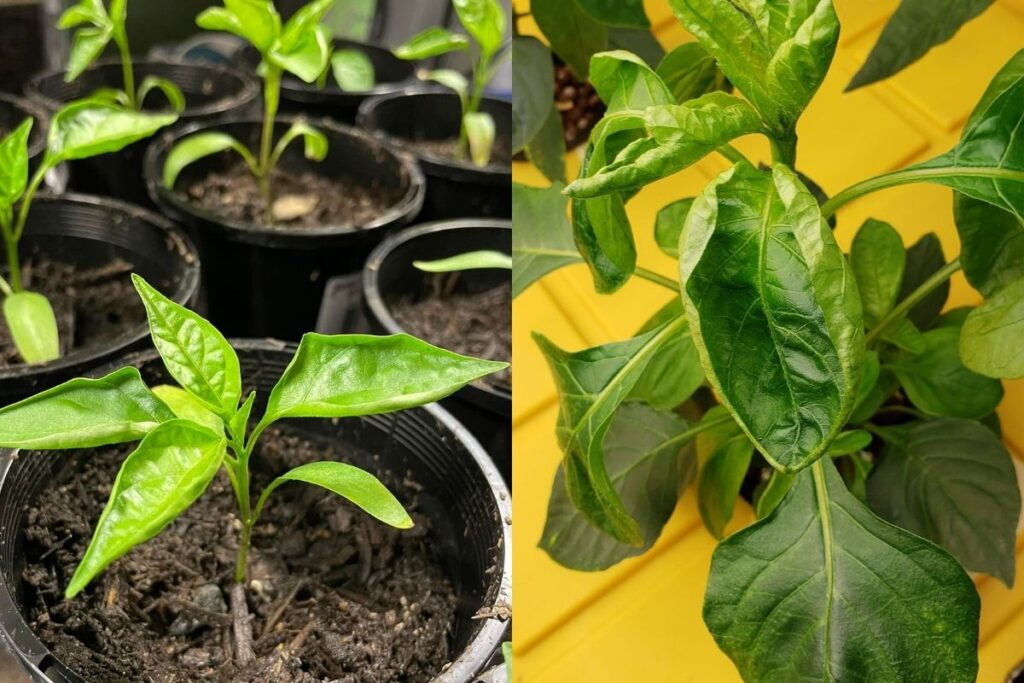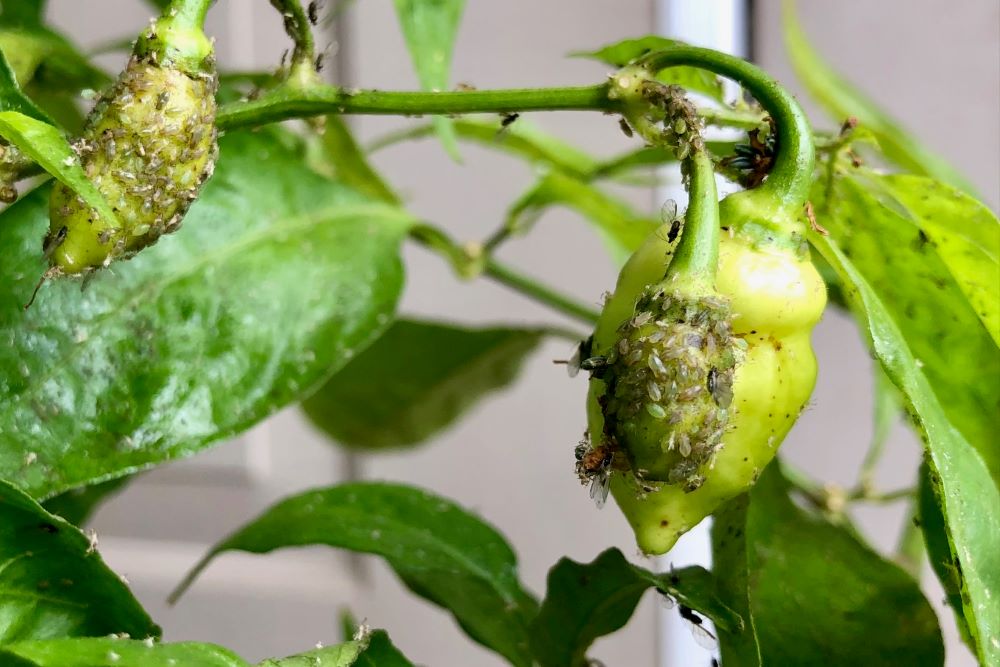Growing peppers can be easy when growing conditions are perfect. However, even your next-door neighbor can have a completely different environment that can impact their plant growth. As with anything that is alive, stressful conditions cause problems.
With peppers, your plants will give clear signals when something is wrong. One common issue we see with pepper plants is curling leaves. It can happen for several reasons, and in this article I will discuss what you can do when your pepper leaves are curling.
If you’ve noticed the leaves on your banana pepper plants curling or distorting, don’t panic! Curled leaves are usually a sign that your plant is stressed and trying to tell you something is wrong with its growing conditions. In this article, we’ll explore the most common reasons for banana pepper leaf curl and how to get your plants back to vigorous growth.

What Causes Banana Pepper Leaves to Curl?
There are several possible causes of curled twisted or otherwise distorted banana pepper leaves
- Over or under-watering
- Improper soil moisture
- Nutrient deficiencies
- Extreme temperatures
- Excessive sunlight
- Root damage or restriction
- Pests or diseases
- Herbicide injury
The most common reasons for curling are inconsistent watering, intense sun exposure, and nutrient deficiencies. Banana peppers are very sensitive to their growing conditions, so any extremes or rapid changes can quickly impact leaf health.
Signs of Specific Problems
The exact way the leaves twist or distort can sometimes point to the underlying cause Here are some telltale symptoms
- Drooping, limp leaves – Usually a sign of under-watering. Leaves lose turgor pressure without enough moisture.
- Leaves curling upward – Can indicate too much sun or heat exposure as the plant tries to minimize surface area.
- Leaves curling downward – Typically a result of overwatering or root issues limiting moisture uptake.
- Cupped, taco-shaped leaves – Strong indicator of herbicide damage from drift or contaminated soil.
- Leaves curling inward – May signal a nutrient deficiency like low nitrogen or calcium preventing proper cell growth.
- Leaves twisting and curling – Can be seen with root-knot nematode infestations restricting nutrient flow.
Correcting the Growing Conditions
Once you determine the likely cause of the curled leaves, you can take steps to remedy the situation:
- Adjust your watering frequency and volume to keep soil evenly moist but not saturated.
- Provide afternoon shade if plants are becoming sunscalded.
- Switch to a high-nitrogen fertilizer or add calcium supplements if deficiency is suspected.
- Rule out root issues like girdling or compaction.
- Inspect closely for small pests like spider mites.
- Avoid spraying herbicides near susceptible pepper plants.
- Monitor for diseases and treat if any fungi are identified.
With some tlc and troubleshooting, you can get your banana peppers back in top shape! But let’s look more closely at the most common curling causes and solutions:
Overwatering
It’s easy to overdo it with watering, especially in hot climates. But too much moisture can quickly lead to root rot and other problems. Signs include:
- Leaves drooping and curling downward
- Wilting leaves even when soil is wet
- Stunted growth
- Roots appear brown or mushy
Fix: Cut back on watering frequency and volume. Check soil moisture before watering and wait for top few inches to dry out. Improve drainage if needed.
Underwatering
While overwatering is common, letting plants get too dry can also cause leaves to distort. Underwatering signs:
- Leaves limp, drooping, or shriveled
- Growth is stunted
- Soil pulls away from pot edges when dry
Fix: Water thoroughly until excess drains out bottom when top inch of soil is dry. Upgrade to a self-watering system for convenience.
Excessive Sunlight
Banana peppers thrive in full sun but sudden exposure to intense summer sun can cause leaves to curl upward to minimize sun exposure. You may notice:
- Leaf edges appear burnt or bleached
- Leaves cup upward severely
- Sunscald scorching on leaves
Fix: Provide shade cloths or screens to filter afternoon sun. Move plants if area gets too hot. Mist leaves to cool.
Nutrient Deficiencies
Lacking key nutrients like nitrogen and calcium leads to misshapen growth. Signs can include:
- Leaves stiff, curled, or twisted
- Interveinal yellowing on leaves
- Purpling of leaf undersides
- Poor fruit set
Fix: Test soil and apply a balanced fertilizer as needed. Focus on nitrogen and calcium sources.
Preventing Future Leaf Curl
Once you remedy the current leaf curling, keep your banana peppers happy and healthy with these tips:
-Water early in the day to allow leaves to dry out
-Use drip irrigation instead of overhead watering
-Add organic mulch to stabilize moisture and temperature
-Provide shade covers if heat exceeds 85°F
-Test soil annually and amend as needed
-Prune lower leaves to enhance air circulation
-Monitor for pests like spider mites routinely
-Avoid damaging roots by staking plants vs. frequent tillage
When to Worry about Curled Leaves
Mild curling from temporary stress usually isn’t a major concern. But if your fixes aren’t working, the damage worsens, or plants decline rapidly, underlying problems like disease or major nutrient issues may be to blame.
Don’t hesitate to send a sample to a diagnostic lab if curling persists. Catching problems early makes treatment much easier.
With a little attentive care and monitoring, you can get those banana pepper leaves looking lush and happy again all season long! Just be patient, fix any environmental issues, and your plants will reward you with a bountiful pepper harvest.
Too Much Light
Providing light to your pepper plants is essential from day 1. Most pepper varieties like full sunlight throughout the season, so if you are planting outdoors, lighting is unlikely to be the issue.
A more common issue is caused by using indoor grow lights incorrectly. Grow lights can vary widely in brightness and intensity. They are essential if you start your own pepper seeds indoors, but you have to follow your grow light’s instructions for how close the lights should be to your plants.
See our recommended grow lights here.

If your plants are too close to the light, you will begin to see the leaves curling up and closing in rebellion from the intense light. This problem can eventually cause pepper leaves to dry up and fall off, often turning brown and crumbling when squeezed.
Keep in mind, this issue usually affects young, tender plants more than mature peppers. Seedlings are more delicate than fully-formed plants.
The solution: If you think your plants have light burn, adjust your lights a few inches higher. Our grow light needs to be 12-18 inches away from the canopy of leaves.
Also, make sure the lights are set on a timer to be on for 12-16 hours, and off for the rest of the day. Check that the timer is working properly, as 24/7 light is not good!
If your outdoor plants have leaf curl, the issue is not likely to be lighting. One possible cause is improper hardening off. When indoor plants move outside, they must be gradually adjusted to the direct sunlight. Sudden exposure can lead to curling and sun scald.
Unchecked insect infestations can quickly become the bane of your garden. They come from seemingly nowhere and can wreak havoc on your plants in a matter of days.
Curling pepper leaves can be a sign of a pest problem, though it will typically be focused on individual leaves rather than the whole plant. Curled and bubbled leaves could be the leaves that the insects have been feeding on.

If the entire pepper plant has curled leaves, it is likely one of the other issues mentioned. However, if you notice localized leaf curling, you may have aphids, thrips, spider mites, or another pest.
Unfortunately, pest removal is more difficult than preventative care. However, you can take some measures to try to alleviate the issue and get rid of most of the insects.
The solution: Spray off aphids and other sap sucking insects with water. For extra protection, use insecticidal soap spray. Also, plant alyssum and other beneficial companion plants to attract predatory insects that eat common pests.
As a preventative measure, diluted neem oil spray can be effective – simply work the suggested amount into your soil before transplanting, or spray a diluted solution onto the foliage.
Why are my Pepper Plant Leaves Curling? How to Stop Leaf Roll – Pepper Geek
FAQ
Why are my Banana Pepper leaves curling?
How do you fix curling leaves on plants?
What does it mean when banana leaves curl?
